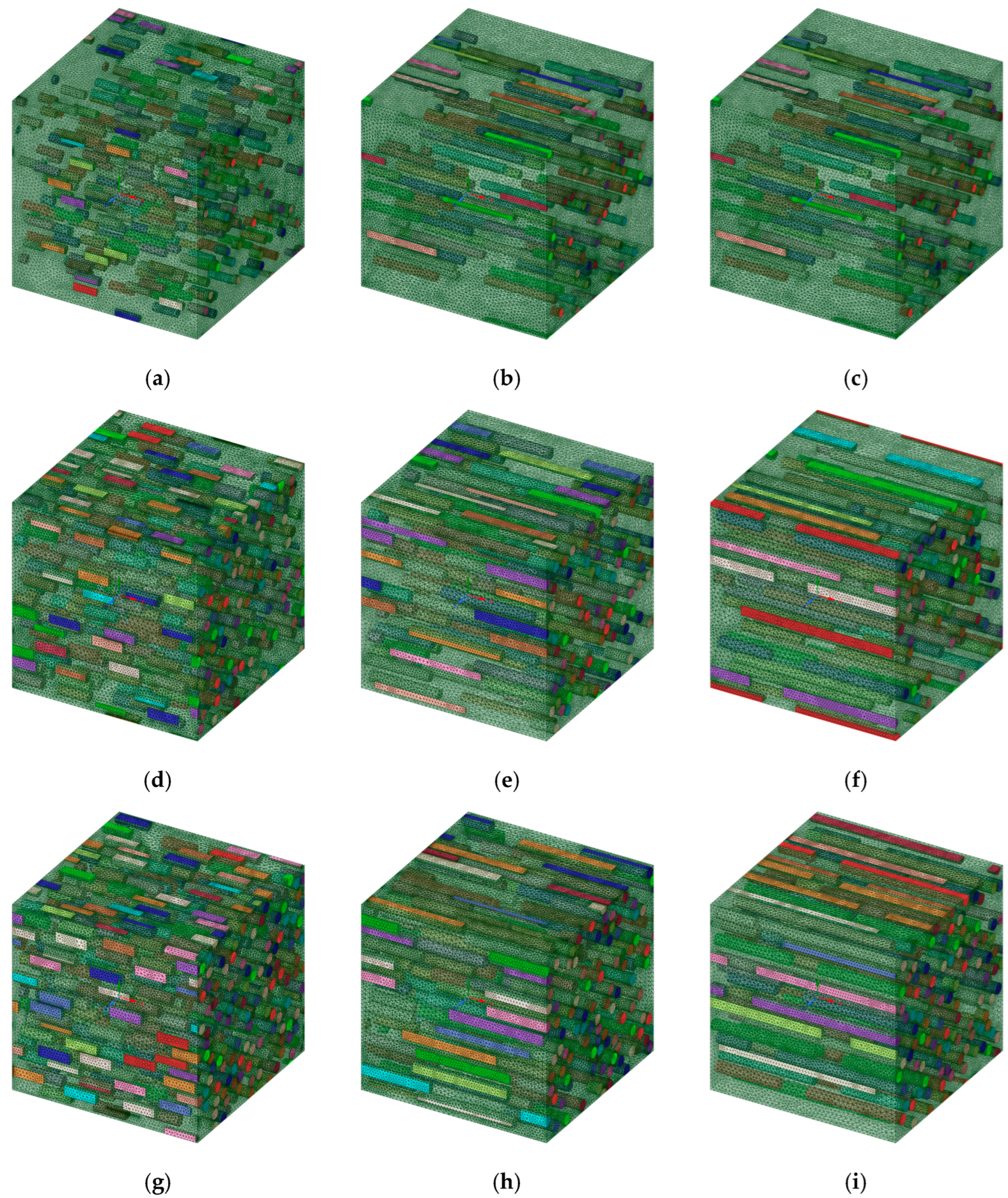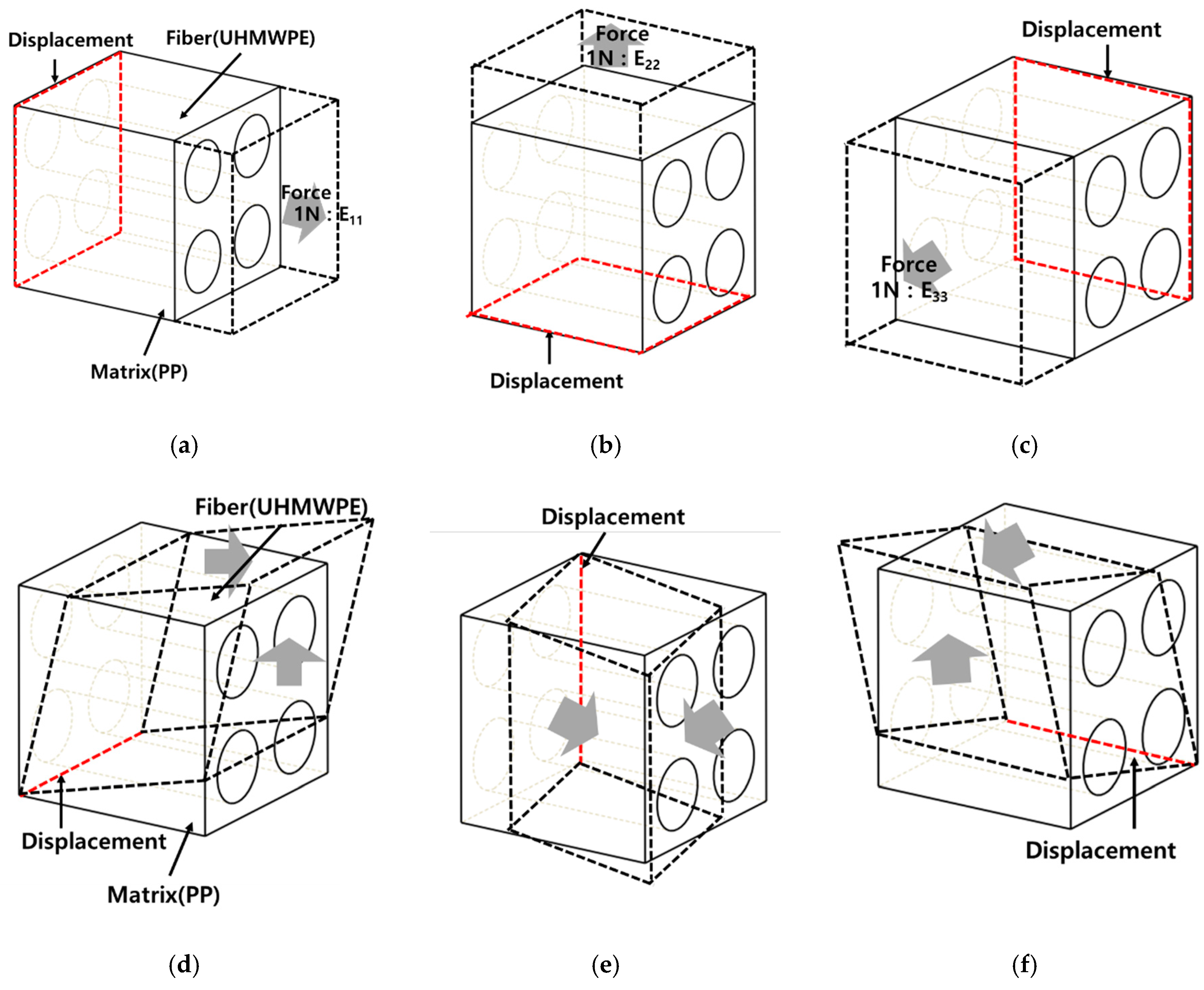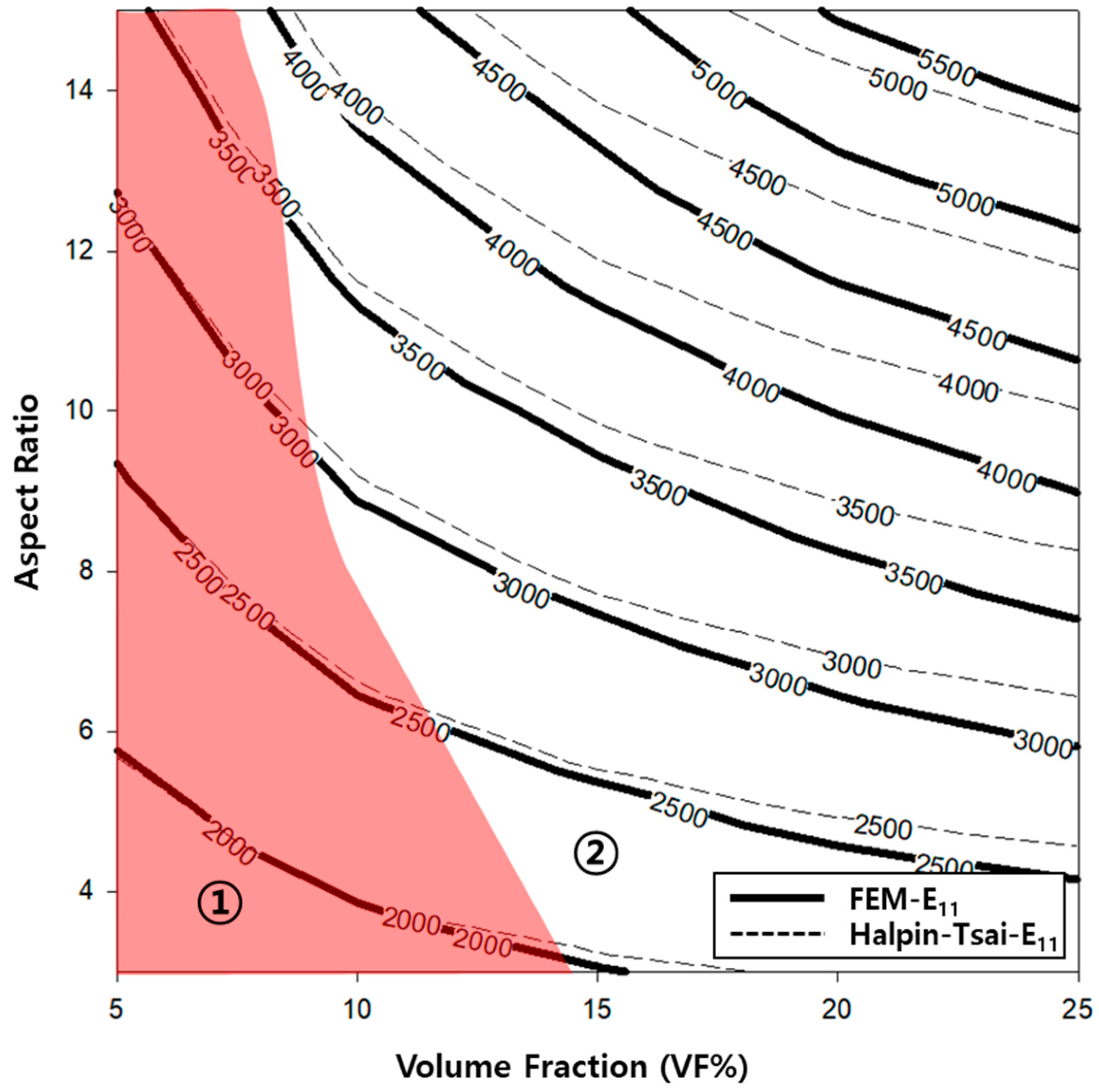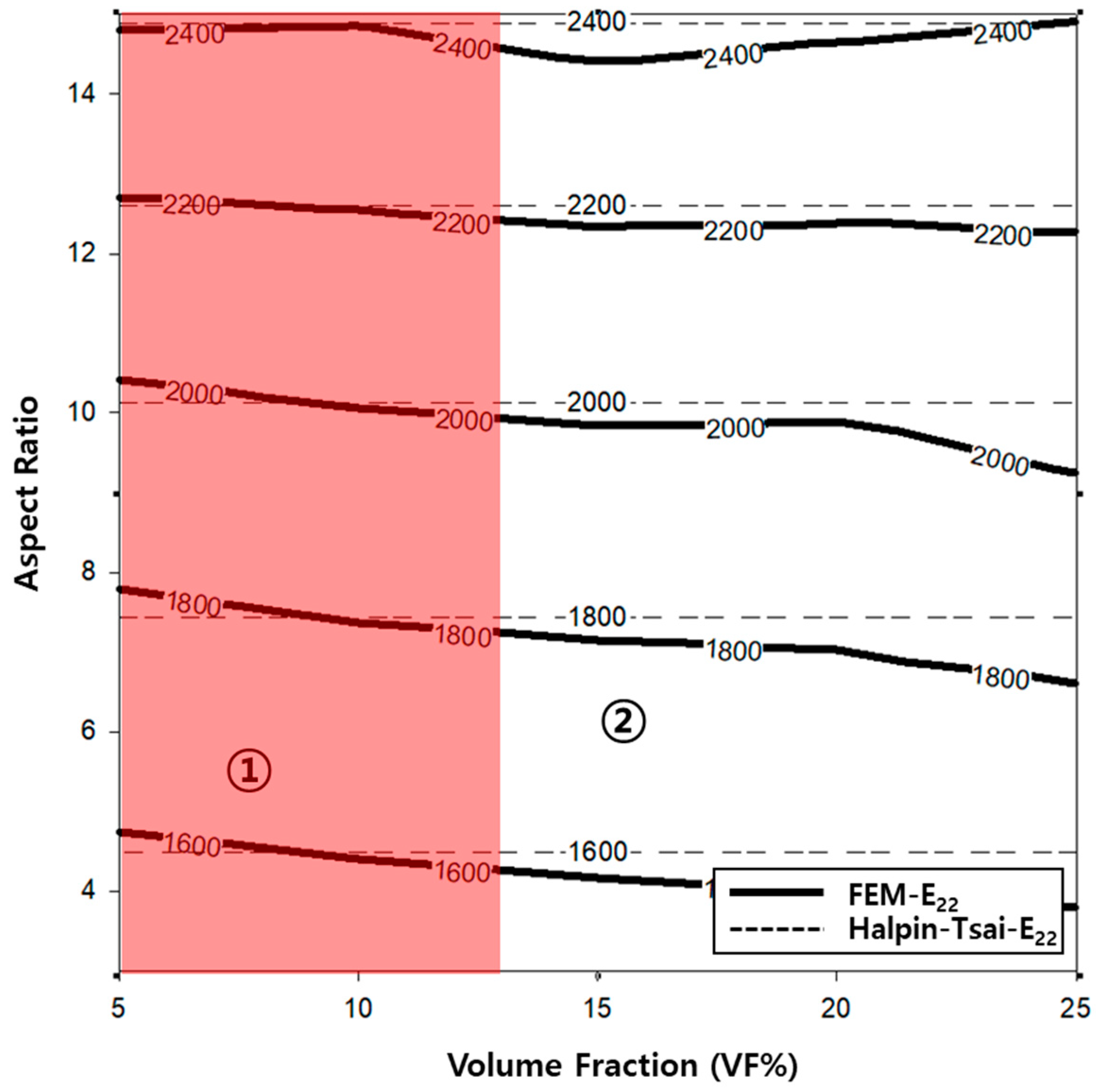Numerical Investigation of the Elastic Properties of Polypropylene/Ultra High Molecular Weight Polyethylene Fiber inside a Composite Material Based on Its Aspect Ratio and Volume Fraction
Abstract
:1. Introduction
2. Materials and Methods
3. Results
4. Discussion
5. Conclusions
Author Contributions
Funding
Conflicts of Interest
References
- Bush:, J.W.; Sousanis, J.; Zajaz, P. Ward’s Motor Vehicle Fact’s and Figures; Ward’s Automotive Group: Southfield, MI, USA, 2006. [Google Scholar]
- Sarfraz, M.S.; Hong, H.; Kim, S.S. Recent developments in the manufacturing technologies of composite components and their cost-effectiveness in the automotive industry: A review study. Compos. Struct. 2021, 266, 113864. [Google Scholar] [CrossRef]
- Lee, J.M.; Min, B.J.; Park, J.H.; Kim, D.H.; Kim, B.M.; Ko, D.C. Design of lightweight CFRP automotive part as an alternative for steel part by thickness and lay-up optimization. Materials 2019, 12, 2309. [Google Scholar] [CrossRef] [PubMed] [Green Version]
- Carlson, T.; Ordéus, D.; Wysocki, M.; Asp, L.E. CFRP structural capacitor materials for automotive applications. Plast. Rubber Compos. 2011, 40, 311–316. [Google Scholar] [CrossRef]
- Forcellese, A.; Marconi, M.; Simoncini, M.; Vita, A. Life cycle impact assessment of different manufacturing technologies for automotive CFRP components. J. Clean. Product. 2020, 271, 122677. [Google Scholar] [CrossRef]
- Othman, R.; Ismail, N.I.; Pahmi, M.A.A.H.; Basri, M.H.M.; Sharudin, H.; Hemdi, A.R. Application of Carbon fiber reinforced plastics in automotive industry: A review. J. Mech. Manuf. 2018, 1, 144–154. [Google Scholar]
- Lescheticky, J.; Barnes, G.; Schrank, M. System Level Design Simulation to Predict Passive Safety Performance for CFRP Automotive Structures; (No. 2013-01-0663); SAE Technical Paper; SAE: Evanston, IL, USA, 2013. [Google Scholar] [CrossRef]
- Becker, F.; Hopmann, C.; Italiano, F.; Girelli, A. Fatigue testing of GFRP materials for the application in automotive leaf springs. Procedia Struct. Integr. 2019, 19, 645–654. [Google Scholar] [CrossRef]
- Wu, T.; Tinkloh, S.R.; Tröster, T.; Zinn, W.; Niendorf, T. Residual stress measurements in GFRP/steel hybrid components. In Proceedings of the 4th International Conference Hybrid, Online, 28–29 April 2020. [Google Scholar]
- Kim, D.H.; Kang, S.Y.; Kim, H.J.; Kim, H.S. Strain rate dependent mechanical behavior of glass fiber reinforced polypropylene composites and its effect on the performance of automotive bumper beam structure. Compos. Part B Eng. 2019, 166, 483–496. [Google Scholar] [CrossRef]
- Gohari, S.; Sharifi, S.; Burvill, C.; Mouloodi, S.; Izadifar, M.; Thissen, P. Localized failure analysis of internally pressurized laminated ellipsoidal woven GFRP composite domes: Analytical, numerical, and experimental studies. Arch. Civil Mech. Eng. 2019, 19, 1235–1250. [Google Scholar] [CrossRef]
- Saghir, F.; Gohari, S.; Moslemi, N.; Abdi, B.; Moloudi, S.; Burvill, C.; Lucas, S. A semi-empirical approach to evaluate the effect of constituent materials on mechanical strengths of GFRP mortar pipes. In Structures; Elsevier: Amsterdam, The Netherlands, 2022; Volume 36, pp. 493–510. [Google Scholar]
- Monti, M.; Palenzona, M.; Fiorino, F.; Baudach, F.; Onnis, A.; Romeo, A. Design, manufacturing and FEA prediction of the mechanical behavior of a hybrid-molded polycarbonate/continuous carbon fiber reinforced composite component. Compos. Part B Eng. 2022, 238, 109891. [Google Scholar] [CrossRef]
- Malkapuram, R.; Kumar, V.; Negi, Y.S. Recent development in natural fiber reinforced polypropylene composites. J. Reinf. Plast. Compos. 2009, 28, 1169–1189. [Google Scholar] [CrossRef]
- Shubhra, Q.T.; Alam, A.M.; Quaiyyum, M.A. Mechanical properties of polypropylene composites: A review. J. Thermoplast. Compos. Mater. 2013, 26, 362–391. [Google Scholar] [CrossRef]
- Karsli, N.G.; Aytac, A. Effects of maleated polypropylene on the morphology, thermal and mechanical properties of short carbon fiber reinforced polypropylene composites. Mater. Des. 2011, 32, 4069–4073. [Google Scholar] [CrossRef]
- Barkoula, N.M.; Alcock, B.; Cabrera, N.O.; Peijs, T. Fatigue properties of highly oriented polypropylene tapes and all-polypropylene composites. Polym. Polym. Compos. 2008, 16, 101–113. [Google Scholar] [CrossRef] [Green Version]
- Aboudi, J. The effective moduli of short-fiber composites. Int. J. Solids Struct. 1983, 19, 693–707. [Google Scholar] [CrossRef]
- Zhu, Y.T.; Beyerlein, I.J. Bone-shaped short fiber composites—An overview. Mater. Sci. Eng. A 2002, 326, 208–227. [Google Scholar] [CrossRef]
- Garoushi, S.; Gargoum, A.; Vallittu, P.K.; Lassila, L. Short fiber-reinforced composite restorations: A review of the current literature. J. Investig. Clin. Dent. 2018, 9, e12330. [Google Scholar] [CrossRef]
- Nguyen, B.N.; Bapanapalli, S.K.; Holbery, J.D.; Smith, M.T.; Kunc, V.; Frame, B.J.; Phelps, J.H.; Tucker, C.L., III. Fiber length and orientation in long-fiber injection-molded thermoplastics—Part I: Modeling of microstructure and elastic properties. J. Compos. Mater. 2008, 42, 1003–1029. [Google Scholar] [CrossRef]
- Xu, B.; Yin, S.; Wang, Y.; Li, H.; Zhang, B.; Ritchie, R.O. Long-fiber reinforced thermoplastic composite lattice structures: Fabrication and compressive properties. Compos. Part A Appl. Sci. Manuf. 2017, 97, 41–50. [Google Scholar] [CrossRef]
- Mikata, Y.; Taya, M. Stress field in a coated continuous fiber composite subjected to thermo-mechanical loadings. J. Compos. Mater. 1985, 19, 554–578. [Google Scholar] [CrossRef]
- Lavoie, J.A.; Soutis, C.; Morton, J. Apparent strength scaling in continuous fiber composite laminates. Compos. Sci. Technol. 2000, 60, 283–299. [Google Scholar] [CrossRef]
- An, Y.; Gu, L.; Wang, Y.; Li, Y.M.; Yang, W.; Xie, B.H.; Yang, M.B. Morphologies of injection molded isotactic polypropylene/ultra high molecular weight polyethylene blends. Mater. Des. 2012, 35, 633–639. [Google Scholar] [CrossRef]
- An, Y.; Bao, R.Y.; Liu, Z.Y.; Wu, X.J.; Yang, W.; Xie, B.H.; Yang, M.B. Unusual hierarchical structures of mini-injection molded isotactic polypropylene/ultrahigh molecular weight polyethylene blends. Eur. Polym. J. 2013, 49, 538–548. [Google Scholar] [CrossRef]
- Unger, T.; Klocke, L.; Herrington, K.; Miethlinger, J. Investigation of the rheological and mechanical behavior of Polypropylene/ultra-high molecular weight polyethylene compounds related to new online process control. Polym. Test. 2020, 86, 106442. [Google Scholar] [CrossRef]
- Liu, G.R. A step-by-step method of rule-of-mixture of fiber-and particle-reinforced composite materials. Compos. Struct. 1997, 40, 313–322. [Google Scholar] [CrossRef]
- Park, D.M.; Kim, J.H.; Lee, S.J.; Yoon, G.H. Analysis of geometrical characteristics of CNT-Al composite using molecular dynamics and the modified rule of mixture (MROM). J. Mech. Sci. Technol. 2018, 32, 5845–5853. [Google Scholar] [CrossRef]
- Sarkar, B.K.; Mukherjee, M.K.; Natarajan, A. A modification of the rule of mixture in estimating strengths of a composite. Mater. Werkst. 1982, 13, 269–273. [Google Scholar] [CrossRef]
- Wongpajan, R.; Mathurosemontri, S.; Takematsu, R.; Xu, H.Y.; Uawongsuwan, P.; Thumsorn, S.; Hamada, H. Interfacial shear strength of glass fiber reinforced polymer composites by the modified rule of mixture and Kelly-Tyson model. Energy Procedia 2016, 89, 328–334. [Google Scholar] [CrossRef] [Green Version]
- Luo, Z.; Li, X.; Shang, J.; Zhu, H.; Fang, D. Modified rule of mixtures and Halpin–Tsai model for prediction of tensile strength of micron-sized reinforced composites and Young’s modulus of multiscale reinforced composites for direct extrusion fabrication. Adv. Mech. Eng. 2018, 10, 1687814018785286. [Google Scholar] [CrossRef]
- Rayhan, S.B.; Rahman, M.M. Modeling elastic properties of unidirectional composite materials using Ansys Material Designer. Procedia Struct. Integr. 2020, 28, 1892–1900. [Google Scholar] [CrossRef]
- Vignoli, L.L.; Savi, M.A.; Pacheco, P.M.; Kalamkarov, A.L. Micromechanical analysis of transversal strength of composite laminae. Compos. Struct. 2020, 250, 112546. [Google Scholar] [CrossRef]
- Yung, K.C.; Wang, J.; Yue, T.M. Modeling Young’s modulus of polymer-layered silicate nanocomposites using a modified Halpin—Tsai micromechanical model. J. Reinf. Plast. Compos. 2006, 25, 847–861. [Google Scholar] [CrossRef]
- Zare, Y. Development of Halpin-Tsai model for polymer nanocomposites assuming interphase properties and nanofiller size. Polym. Test. 2016, 51, 69–73. [Google Scholar] [CrossRef]
- Ebrahimi, F.; Dabbagh, A. Vibration analysis of multi-scale hybrid nanocomposite plates based on a Halpin-Tsai homogenization model. Compos. Part B Eng. 2019, 173, 106955. [Google Scholar] [CrossRef]
- Osoka, E.C.; Onukwuli, O.D. A modified Halpin-Tsai model for estimating the modulus of natural fiber reinforced composites. Int. J. Eng. Sci. Invent. 2018, 7, 63–70. [Google Scholar]
- Giner, E.; Vercher, A.; Marco, M.; Arango, C. Estimation of the reinforcement factor ξ for calculating the transverse stiffness E2 with the Halpin–Tsai equations using the finite element method. Compos. Struct. 2015, 124, 402–408. [Google Scholar] [CrossRef] [Green Version]
- Mahmun, A.; Kirtania, S. Evaluation of elastic properties of graphene nanoplatelet/epoxy nanocomposites. Mater. Today Proc. 2021, 44, 1531–1535. [Google Scholar] [CrossRef]
- Greco, F.; Luciano, R. A theoretical and numerical stability analysis for composite micro-structures by using homogenization theory. Compos. Part B Eng. 2011, 42, 382–401. [Google Scholar] [CrossRef]
- Otero, F.; Oller, S.; Martinez, X.; Salomón, O. Numerical homogenization for composite materials analysis. Comparison with other micro mechanical formulations. Compos. Struct. 2015, 122, 405–416. [Google Scholar] [CrossRef] [Green Version]
- Kalidindi, S.R.; Binci, M.; Fullwood, D.; Adams, B.L. Elastic properties closures using second-order homogenization theories: Case studies in composites of two isotropic constituents. Acta Mater. 2006, 54, 3117–3126. [Google Scholar] [CrossRef]










| PP | UHMWPE | |
|---|---|---|
| modulus of elasticity (MPa) | 1325 | 25,000 |
| shear modulus (MPa) | 432.29 | 10,417 |
| Poisson’s ratio | 0.43 | 0.20 |
| bulk modulus of elasticity (MPa) | 3154.8 | 13,889.0 |
| density (kg/m3) | 904 | 950 |
Publisher’s Note: MDPI stays neutral with regard to jurisdictional claims in published maps and institutional affiliations. |
© 2022 by the authors. Licensee MDPI, Basel, Switzerland. This article is an open access article distributed under the terms and conditions of the Creative Commons Attribution (CC BY) license (https://creativecommons.org/licenses/by/4.0/).
Share and Cite
Yun, J.-H.; Jeon, Y.-J.; Kang, M.-S. Numerical Investigation of the Elastic Properties of Polypropylene/Ultra High Molecular Weight Polyethylene Fiber inside a Composite Material Based on Its Aspect Ratio and Volume Fraction. Polymers 2022, 14, 4851. https://doi.org/10.3390/polym14224851
Yun J-H, Jeon Y-J, Kang M-S. Numerical Investigation of the Elastic Properties of Polypropylene/Ultra High Molecular Weight Polyethylene Fiber inside a Composite Material Based on Its Aspect Ratio and Volume Fraction. Polymers. 2022; 14(22):4851. https://doi.org/10.3390/polym14224851
Chicago/Turabian StyleYun, Jong-Hwan, Yu-Jae Jeon, and Min-Soo Kang. 2022. "Numerical Investigation of the Elastic Properties of Polypropylene/Ultra High Molecular Weight Polyethylene Fiber inside a Composite Material Based on Its Aspect Ratio and Volume Fraction" Polymers 14, no. 22: 4851. https://doi.org/10.3390/polym14224851
APA StyleYun, J.-H., Jeon, Y.-J., & Kang, M.-S. (2022). Numerical Investigation of the Elastic Properties of Polypropylene/Ultra High Molecular Weight Polyethylene Fiber inside a Composite Material Based on Its Aspect Ratio and Volume Fraction. Polymers, 14(22), 4851. https://doi.org/10.3390/polym14224851







